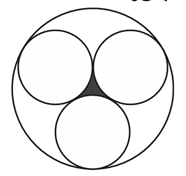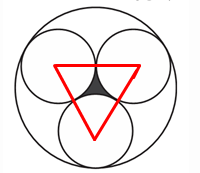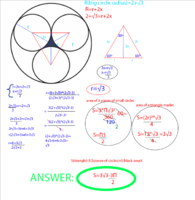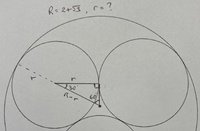You are using an out of date browser. It may not display this or other websites correctly.
You should upgrade or use an alternative browser.
You should upgrade or use an alternative browser.
Find the area of the marked in black
- Thread starter ksardas21
- Start date
Dr.Peterson
Elite Member
- Joined
- Nov 12, 2017
- Messages
- 16,852
What thoughts do you have? Have you tried anything? We need to know what help you need.View attachment 26143
In a circle with a radius of 2+√3, three circles with the same radius are drawn
so that they all touch each other and the big circle (as in the picture).
We need to find the area (S) marked in black between the three circles.
I would start by drawing in radii to all the points of tangency.
Dr.Peterson
Elite Member
- Joined
- Nov 12, 2017
- Messages
- 16,852
Then try something totally random! The important thing is to try something, rather than sit there as if you are totally helpless. You don't need to wait for someone else to do things for you.That's what I triedView attachment 26146
But I have no idea what to do next
There are more radii you can draw -- radii of the larger circle!
Once you've done that, think! Tell us some things you observe, even if you think they are useless.
Then try something totally random! The important thing is to try something, rather than sit there as if you are totally helpless. You don't need to wait for someone else to do things for you.
There are more radii you can draw -- radii of the larger circle!
Once you've done that, think! Tell us some things you observe, even if you think they are useless.
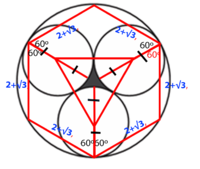
I am here right now
Dr.Peterson
Elite Member
- Joined
- Nov 12, 2017
- Messages
- 16,852
View attachment 26148
I am here right now
Okay, now tell me what thoughts you have.
Think about what your goal is: How might you find that black area? Maybe by subtracting something? What will you need to know in order to to that? (In other words, work backward, looking for possible last steps.)
Think about what more you can determine from what you know: Maybe you can find a radius or two? Maybe the sides of the triangle? (In other words, work forward, looking for possible next steps.)
Think about how you can get from what you know to what you need to know.
This is how you solve a problem: one step at a time. Take a step, and we'll try to catch you if you fall.
By the way, you still haven't drawn any radii for the large circle! That may be necessary, though in fact you have used an implication of that radius already.
It is enough to know the radius of small circle, and S(big circle)-3*S(small circle)= S(black area)Okay, now tell me what thoughts you have.
Think about what your goal is: How might you find that black area? Maybe by subtracting something? What will you need to know in order to to that? (In other words, work backward, looking for possible last steps.)
Think about what more you can determine from what you know: Maybe you can find a radius or two? Maybe the sides of the triangle? (In other words, work forward, looking for possible next steps.)
Think about how you can get from what you know to what you need to know.
This is how you solve a problem: one step at a time. Take a step, and we'll try to catch you if you fall.
By the way, you still haven't drawn any radii for the large circle! That may be necessary, though in fact you have used an implication of that radius already.
yeah my main aim is to somehow find the radius of small circle and I am thinking about the ways of solving this problem
Dr.Peterson
Elite Member
- Joined
- Nov 12, 2017
- Messages
- 16,852
Not quite; if you subtract the small circles from the large circle, you will be left with more than just the black area.It is enough to know the radius of small circle, and S(big circle)-3*S(small circle)= S(black area)
yeah my main aim is to somehow find the radius of small circle and I am thinking about the ways of solving this problem
But you might subtract three sectors of circles from the triangle ...
In any case, yes, finding the radius will be a major step. If you show us some of the ideas you have, we can probably adjust one of them to make it work.
I would focus on the equilateral triangle; what do you know about its altitudes/medians? This will be where it's helpful to extend the lines you've drawn into radii, or even diameters, of the large circle.
Clarification: these lines in triangle are Medians
Dr.Peterson
Elite Member
- Joined
- Nov 12, 2017
- Messages
- 16,852
... and altitudes, and everything else!Clarification: these lines in triangle are Medians
Did you notice that x = 1, which is presumably how they chose R?
Hah, i noticed right now, cool... and altitudes, and everything else!
Did you notice that x = 1, which is presumably how they chose R?
wOW. you are an expert now. awesome steps and an awesome final answer

